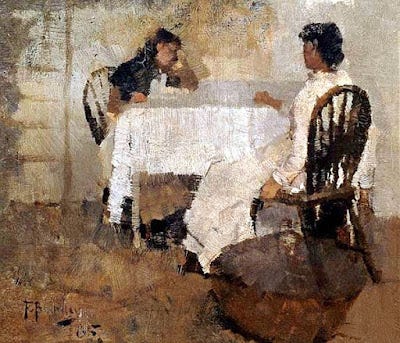Great compositions rarely arrive fully formed in your head. They require rough drafts. A color study is where the magic happens. Here’s an example.
Frank Bramley, Study for Domino!, 8 3/4 x 10 1/4”
For example, Frank Bramley (1857-1915) came up with an interesting idea for a painting: A girl and a woman sit at a table. The white dress fuses with the tablecloth to make a larger shape. And the dark shape of the chair blends with other dark shapes.
Nice idea, but still a little “blah.” The wall and the ground plane are flat and undefined, and the white shape is stuck in the middle.
Look how he develops it. The figures are playing dominoes, adding a feeling of dolce far niente (An Italian phrase celebrating “sweet do-nothing” idleness.
Frank Bramley, Domino!, 24 x 36”
A couple of prints hang on the wall, a carpet covers the floor, and a few stairs lead off to another part of the house, with just a dash of light in the hallway. By developing the Z dimension with foreground and background, he improves the sense of depth. Everything is a foil for the big effect. Those linked white shapes cascade into the foreground, all painted with that angular, square-brush technique.
So, here are the “how-to” bottom lines to take your picture to the next level:
Take the idea as far as you can in a series of rough studies.
Look for storytelling elements to make the picture more resonant.
Add depth by considering the Z-dimension.





Very often, especially with the more realist painters,I enjoy looking at the preparatory sketches more than the final work,my own included.
I think the clutter in the foreground distracts from the focal point.